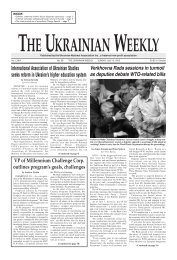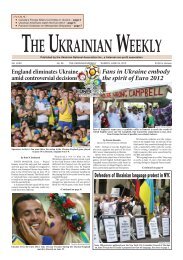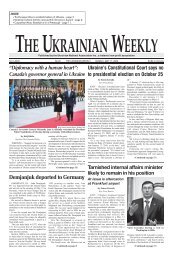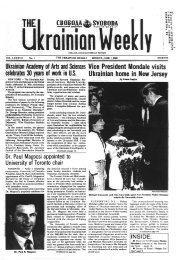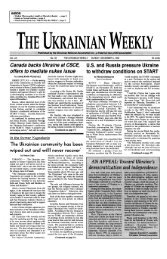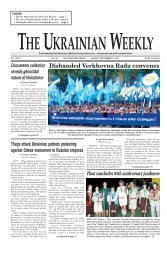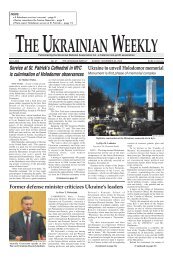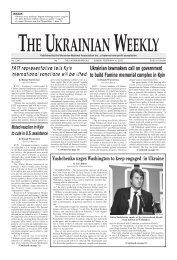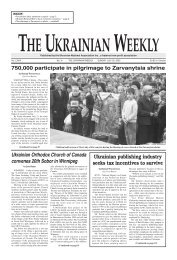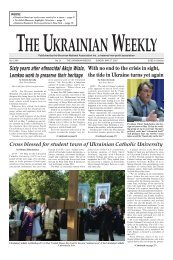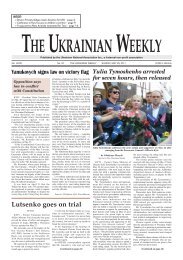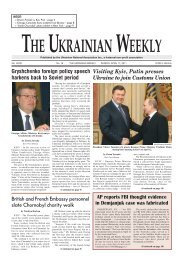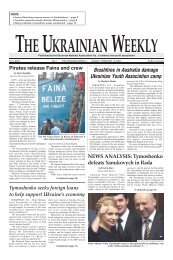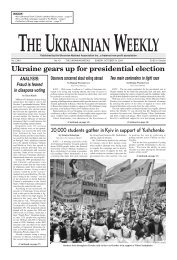Tymoshenko supporters block Rada presidium - The Ukrainian Weekly
Tymoshenko supporters block Rada presidium - The Ukrainian Weekly
Tymoshenko supporters block Rada presidium - The Ukrainian Weekly
Create successful ePaper yourself
Turn your PDF publications into a flip-book with our unique Google optimized e-Paper software.
8<br />
THE UKRAINIAN WEEKLY SUNDAY, DECEMBER 11, 2011<br />
No. 50<br />
<strong>The</strong> church in Peniaky where the first Illya Olesnycky was pastor in 1801.<br />
<strong>The</strong> gravesite in Peniaky of the Rev. Hryhory Hrushka,<br />
founder of Svoboda (1893).<br />
Intersections: A family visit to western Ukraine<br />
<strong>The</strong> cemetery in Peniaky.<br />
This could have been the same exact scene in the village of Peniaky 210 years ago.<br />
by Nestor Olesnycky<br />
In October my wife, Ivanka, and I visited<br />
Ukraine to see our son, Damian, who has<br />
been living in Kyiv since 2009. On this trip,<br />
we wanted to combine time with him with<br />
traveling to western Ukraine to visit some<br />
ancestral locations for both our families. We<br />
have lately been immersed in studying our<br />
genealogy from family records, interviewing<br />
family members and frequently using the<br />
internet site Ancestry.com. This was a good<br />
opportunity to expand our research.<br />
<strong>The</strong> Olesnycky family history was written<br />
over a century ago in an autobiography<br />
by Evhen Olesnycky, a lawyer in Stryi, but<br />
not published until 1935 well after his<br />
death. A newer, fuller edition was republished<br />
in July of 2011 in Lviv by Medetsyna<br />
i Pravo. His autobiography fired my desire<br />
to immerse myself in my family’s history<br />
and perhaps discover unknown relatives or<br />
ancestors from an earlier time than Evhen<br />
had mentioned.<br />
According to him, the earliest known<br />
Olesnycky ancestor was Illya Olesnycky<br />
(hereafter Illya [1]) (about 1760-1810), my<br />
great-great-great grandfather. Evhen writes<br />
that Illya [1] was likely a “szliachtycz” of<br />
Polish ancestry, who, as a child, survived the<br />
massacre of his entire family in Uman in<br />
1768, was rescued by a servant, and was<br />
then sheltered and raised by a Rusyn<br />
Orthodox priest. (Evhen indicates that he<br />
used the word “Rusyn” interchangeably<br />
with “<strong>Ukrainian</strong>” when the latter term was<br />
not yet generally accepted.)<br />
Illya himself had converted from Roman<br />
Catholicism to become a <strong>Ukrainian</strong> Orthodox<br />
priest, married the daughter of the priest<br />
who raised him, and had at least one son,<br />
Illya [2], born about 1790 in Volyn. In 1801<br />
Illya [1] converted to Uniate Catholicism and,<br />
according to Evhen, became the pastor of the<br />
<strong>Ukrainian</strong> Catholic Church of the Protection<br />
of the Mother of God in Peniaky, near Brody,<br />
now in Lviv Oblast.<br />
For that reason, we decided to visit<br />
Peniaky, about a two-hour drive east of Lviv,<br />
hoping either to see the church where he<br />
had been pastor, or perhaps even to see his<br />
gravesite.<br />
(I would be remiss if here I didn’t thank<br />
Lesia Isajevych Mason, director of the Sabre<br />
Svitlo Foundation in Lviv, who graciously<br />
assisted us in our efforts to obtain birth and<br />
other family records from the Lviv National<br />
Archives and also provided us with an excellent<br />
guide, Roman Ben, to drive us to Peniaky<br />
and to other sites where we needed to go.)<br />
When we got to Peniaky, a village elder<br />
(former “holova silrady” or head of the<br />
Village Council, Yosyp Ivanovych Bliuy)<br />
accompanied us to the Church where I took<br />
the photo accompanying this article. He was<br />
moved that I was likely seeing where my<br />
most ancient known ancestor had lived and<br />
worked.<br />
Assuming Illya was buried in Peniaky, we<br />
then tried to find his burial site, but that<br />
proved impossible, due to the age and obliteration<br />
of the engraved names on the<br />
ancient monuments in the cemetery and to<br />
the fact that the cemetery was moved as a<br />
result of intense damage during World War<br />
I. To boot, nobody in the village remembered<br />
hearing or reading about such a<br />
name, nor was Illya’s name listed among the<br />
priests and pastors of the church in a book<br />
about Peniaky (“Moye Ridne Selo”) published<br />
in the 1990s.<br />
So, although we were happy to have visited<br />
the village, I was somewhat disappointed,<br />
wondering whether Evhen had it wrong.<br />
Perhaps sensing my disappointment, Mr.<br />
Bliuy proudly pointed out the most prominent<br />
gravestone in the cemetery in Peniaky.<br />
It was that of the Rev. Hryhory Hrushka, the<br />
founder and first editor of Svoboda in 1893,<br />
who was also instrumental in the founding<br />
of the <strong>Ukrainian</strong> National Association. Father<br />
Hrushka was a pastor of the Church in<br />
Peniaky from 1906 to 1913.<br />
He then mentioned the name of yet<br />
another prior pastor of the church, the Rev.<br />
Fedir Holovatsky, who happened to be the<br />
father of Jakiv Holovatsky, a member of the<br />
famous “Ruska Triytsia” along with Markian<br />
Shashkevych and Ivan Vahylevych.<br />
Upon reflection, my disappointment was<br />
replaced by wonderment, as I began to contemplate<br />
how these three names, Olesnycky,<br />
Holovatsky and Hrushka tied in with<br />
Peniaky, with my ancestral roots and with<br />
<strong>Ukrainian</strong> self-identification throughout the<br />
years. I didn’t realize what further reading<br />
and research would reveal after I got home.<br />
Even though I had read “<strong>Ukrainian</strong>-<br />
American Citadel” by Dr. Myron B. Kuropas<br />
about the UNA’s history and had been on the<br />
Executive Committee and Supreme<br />
Assembly of the UNA, I had forgotten that<br />
the Rev. Hrushka had moved back to<br />
Ukraine in 1900 after he founded Svoboda<br />
and co-founded the Ruthenian (later,<br />
<strong>Ukrainian</strong>) National Association.<br />
In 1906, Father Hrushka became the pastor<br />
in Peniaky, where he served until his<br />
death in April of 1913 and where he was<br />
buried. In 1937, the UNA purchased a gravestone<br />
made of Italian marble and had it<br />
placed on his gravesite. Mr. Bliuy related<br />
that in 1944, in typical Soviet fashion, Red<br />
Army soldiers fired bullets into his gravestone,<br />
but failed to destroy it, as shown by<br />
the photo reproduced with this article.<br />
Holovatsky and the Ruska Triytsia had an<br />
important influence on the Olesnycky family’s<br />
<strong>Ukrainian</strong> self-identification, and perhaps<br />
crystallized it. As mentioned above, the<br />
(Continued on page 10)



